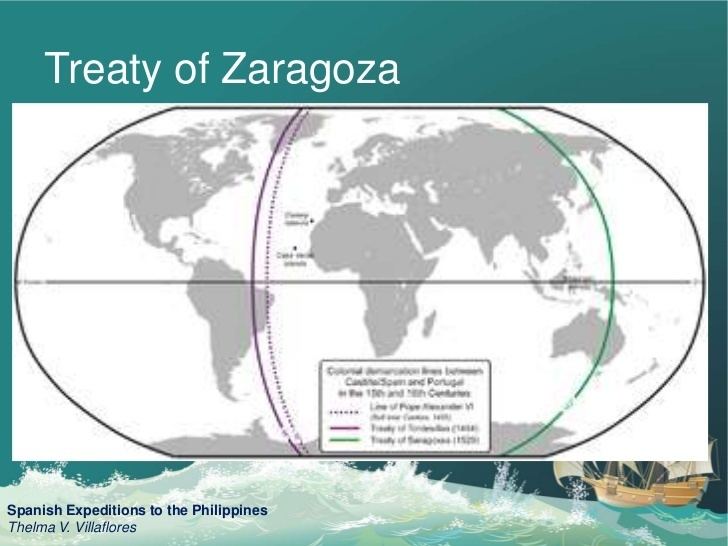 | ||
Similar Treaty of Fontainebleau (1762), Treaty of El Pardo (1778), Treaty of Córdoba | ||
The Treaty of Zaragoza, or Treaty of Saragossa, also referred to as the Capitulation of Zaragoza, was a peace treaty between the Spanish Crown and Portugal, signed on 22 April 1529 by King John III and the Emperor Charles V in the Aragonese city of Zaragoza. The treaty defined the areas of Castilian (Spanish) and Portuguese influence in Asia to resolve the "Moluccas issue", when both kingdoms claimed the Moluccas islands for themselves, considering it within their exploration area established by the Treaty of Tordesillas in 1494. The conflict sprang in 1520, when the expeditions of both kingdoms reached the Pacific Ocean, since there was not a set limit to the east.
Contents

Background: the "Moluccas Issue"
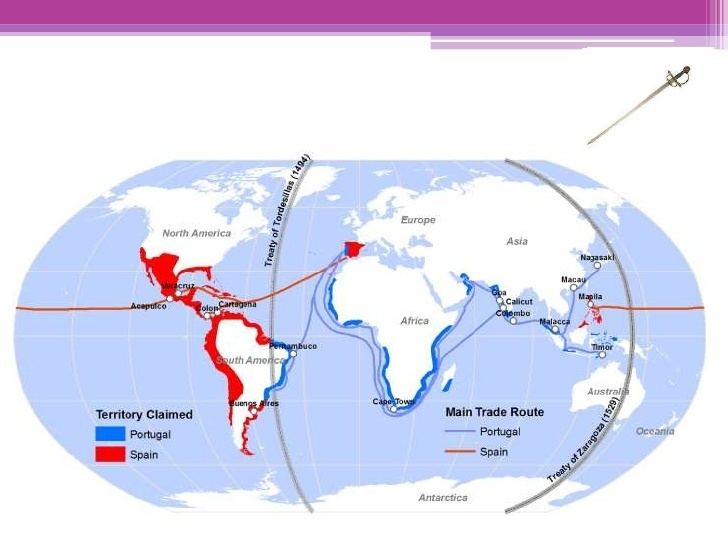
In 1494 Castile and Portugal signed the Treaty of Tordesillas, dividing the world into two exploration and colonizing areas: the Castilian and the Portuguese. It stated a meridian in the Atlantic Ocean, with the western part exclusive to Spain and the east to Portugal.

In 1511 Malacca, then the center of Asian trade, was conquered for Portugal by Afonso de Albuquerque. Getting to know the secret location of the so-called "spice islands" – the Banda Islands in the Moluccas, then the single world source of nutmeg and cloves, main purpose for the travels in the Indian sea – Albuquerque sent an expedition led by António de Abreu in search of the Moluccas, particularly the Banda islands, where they were the first Europeans to arrive in early 1512, passing en route through the Lesser Sunda Islands. Before reaching Banda, they first touched the islands of Buru, Ambon, and Seram, and then the Banda Islands. Later, after a separation forced by a shipwreck, his vice-captain Francisco Serrão, went again to the north and sank off Ternate, where he obtained a license to build a Portuguese fortress-factory: the Forte de São João Baptista de Ternate.
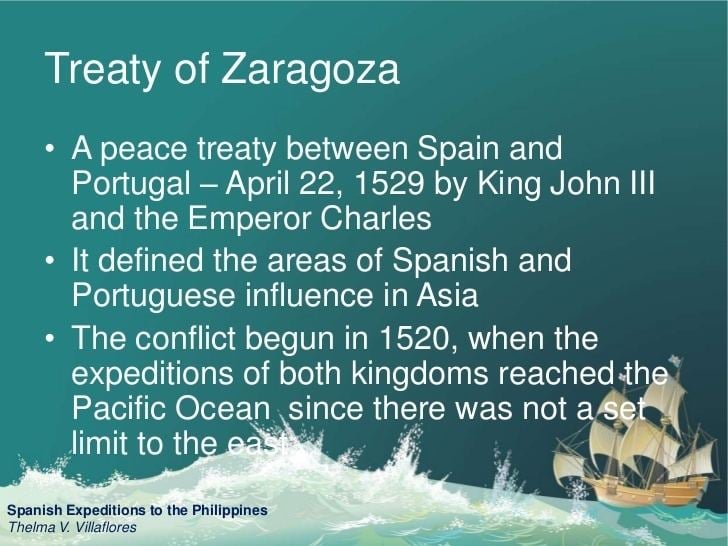
Letters sent from Serrão to Ferdinand Magellan, who were friends and possibly cousins, describing the "Spice Islands", helped Magellan persuade the Spanish crown to finance the first circumnavigation travel. On November 6, 1521, the Moluccas, "cradle of all spices," were reached from the east by Magellan's fleet, sailing then under Juan Sebastián Elcano, at the service of the Spanish Crown. Before Magellan and Serrão could meet in the Moluccas, Serrão died on the island of Ternate, almost at the same time Magellan was killed in the battle of Mactan in the Philippines.
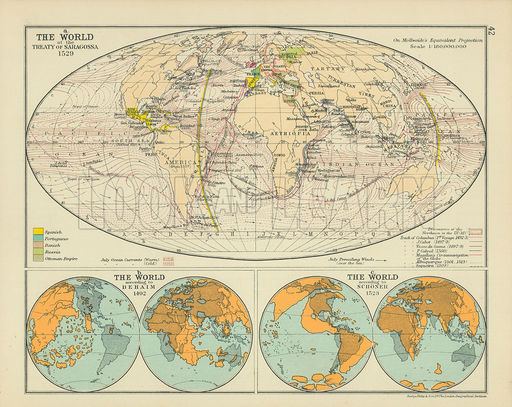
After the Magellan-Elcano expedition (1519–1522), Charles V sent a second expedition led by García Jofre de Loaísa to colonize the islands, based on the claim that they were in the Castilian zone, under the Treaty of Tordesillas. The expedition reached with difficulty the Moluccas, docking at Tidore, where the Spanish later founded a fort. The conflict with the Portuguese already established in Ternate there was inevitable, resulting in the Spanish defeat after a year of fighting, starting nearly a decade of skirmishes over the possession.
Conferences of Badajoz – Elvas
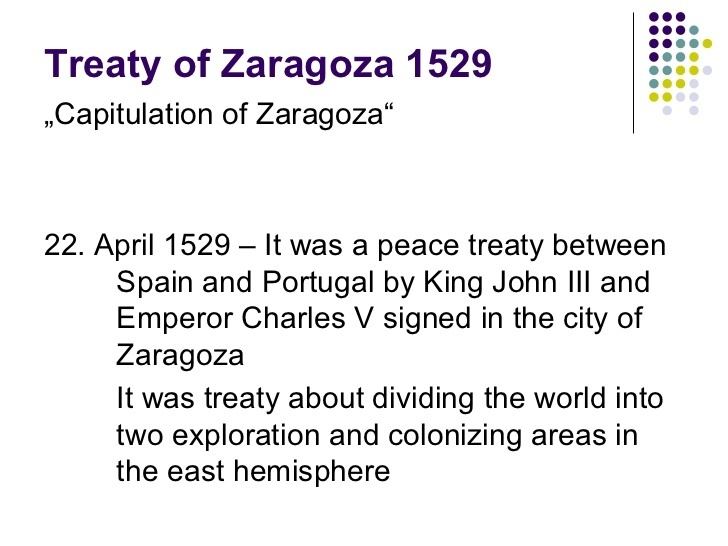
In 1524 both kingdoms organized the Junta de Badajoz-Elvas to resolve the issue. To find the exact location of the antimeridian of Tordesillas, which would divide the world into two equal hemispheres, each crown appointed three astronomers and cartographers, three pilots and three mathematicians. Lopo Homem, Portuguese cartographer and cosmographer was in the Board, Diogo Lopes de Sequeira was another of the participants, along with former Portuguese cartographer Diogo Ribeiro on the Spanish delegation. The board met several times at Badajoz and Elvas, without reaching an agreement: the geographic knowledge at that time was inadequate for an accurate assignment of longitude, and each group simply chose maps or globes that showed the islands in their own hemisphere. John III and Charles V agreed to not send anyone else to get Moluccan spices until finding in whose hemisphere were the islands.

Between 1525 and 1528 Portugal sent several expeditions around the Moluccas. Gomes de Sequeira and Diogo da Rocha were sent by the governor of Ternate Jorge de Meneses to the Celebes (also already visited by Simão de Abreu in 1523) and to the north, being then the first Europeans to reach the Caroline Islands, which they named "Islands de Sequeira ". Explorers such as Martim Afonso de Melo (1522-24), and possible Gomes de Sequeira (1526-1527), sighted the Aru Islands and the Tanimbar Islands. In 1526 Jorge de Meneses reached northwestern Papua New Guinea, landing in Biak (Schouten Islands), and from there he reached Waigeo in the Bird's Head Peninsula.
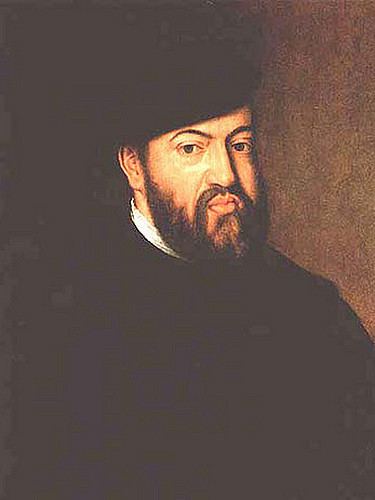
On the other hand, beyond the Loaísa expedition from Spain to the Moluccas (1525-1526), the Castilians sent also via the Pacific (prepared by Hernán Cortés in Mexico), the expedition of Álvaro de Saavedra Cerón (1528), in order to compete with the Portuguese in the region. Members of the Garcia Jofre de Loaísa expedition were made prisoners by the Portuguese and its survivors return to Europe in Portuguese hands by west. Álvaro de Saavedra Cerón reached the Marshall Islands, and in two failed attempts to return from the Moluccas via the Pacific, explored part of west and northern New Guinea, reaching also the Schouten Islands and sighting Yapen, and also the Admiralty Islands and the Carolines.
On February 10, 1525 Charles V's younger sister Catherine of Austria married John III of Portugal and on March 11, 1526, Charles V married king John's sister Isabella of Portugal. These crossed weddings strengthened the ties between the two crowns, easing an agreement on the Moluccas. It was in the interest of the emperor to avoid conflict, to focus on his European policy, and the Spaniards did not know then how to carry the spices from the Moluccas to Europe sailing to east (the Manila-Acapulco route would be discovered by Andrés de Urdaneta only in 1565).
Treaty
The Treaty of Zaragoza stated the meridian was 297.5 leagues (1,763 kilometers, 952 nautical miles) or 17° east of the Maluku Islands as the border between the two domain zones. The treaty had also a safeguard stating that, if at any time the emperor wished to restore the deal, the sale would be undone, with the Portuguese receiving the money they had to pay and each "will have the right and the action as that is now." However, this never happened, because the emperor desperately needed the Portuguese money to finance the war of the League of Cognac against his arch-rival Francis I of France.
The Treaty of Zaragoza, while not amending or providing clarity on the demarcation line established by the Treaty of Tordesillas, did not affirm Spain's claim to hemispheres of equal size (180° each). Consequently, the division resulted in an unequal distribution of the Earth between the two nations. Portugal received approximately 191° of the globe, whereas Spain was allocated roughly 169°. This allocation is subject to a significant margin of uncertainty, estimated at ±4°, attributed to the varying interpretations of the precise location of the Tordesillas line.
Portugal gained control of all lands and seas west of the Zaragoza, including all of Asia and its neighboring islands so far "discovered," leaving Spain most of the Pacific Ocean. Although the Philippines were not named in the treaty, Spain implicitly relinquished any claim to them because they were well west of the line. Nevertheless, by 1542, King Charles V decided to colonize the Philippines, judging that Portugal would not protest too vigorously because the archipelago had no spices, but he failed in his attempt. King Philip II succeeded in 1565, establishing the initial Spanish trading post at Manila, with little opposition from the Portuguese as his father had expected.
The Portuguese delegation sent by King João III included, among others, António de Azevedo Coutinho, Diogo Lopes de Sequeira, Lopo Homem and Simão Fernandes. Plenipotentiaries were, from Portugal, António Azevedo Coutinho, and from Spain, Count Mercurio Gâtine; Garcia de Loaysa, Bishop of Osma; and Garcia de Padilla, commander of Calatrava.
